Lee Industries Blog
Sign up to be notified of our new blog posts.

Chocolate and Confection Manufacturers – Remember the Valve
In the first six months of the pandemic, sales of candy increased 3.8% and chocolate grew 5.5%, with premium chocolate up 12.5%. It is this kind of robust performance that is leading many chocolate and candy producers to expand production and optimize efficiency in their operation. As they do, one area that shouldn’t be overlooked is the performance of their in-line and flush-mounted ball valves.

Soup’s On: What to Consider When Adding Capacity for Soup Production
With a nod to a famous advertising tagline, more and more people around the world are agreeing that “soup is good food”. Even without the spike in demand caused by the pandemic in 2020, the global soup market was on a steady rise. So, it’s no surprise that researchers expect significant growth in the coming years, with global annual value reaching $20B by 2026 – a nearly 20% increase over 2020. This positive outlook – driven by a growing demand for healthy convenience food, mounting interest in global and ethnic culinary offerings and heightened popularity of fresh prepared/ready-to-eat and frozen foods – is leading many soup producers to evaluate their processing operations, to make sure they can consistently churn out enough product to meet demand.

Skincare Products: How to Make Sure You Get the Right Processing Equipment
Beauty may only go skin deep, but clearly, that’s enough to make today’s market for skincare products quite appealing.

Jams, Jellies and Preserves: How to Choose the Right Processing Vessel
As consumers focus on healthy lifestyles and opt for natural products, demand for jam, jelly, and preserve products is growing. This growth, and the arrival of products featuring less sugar and the use of a wider range of spices, herbs and rare or exotic fruits, is leading some manufacturers to consider modifying, upgrading or adding processing equipment to keep pace. Ultimately, their equipment choices can have a significant effect on their overall operational performance. Learn more in our latest blog article:
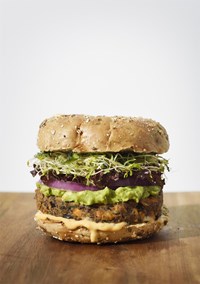
Equipment Considerations for Plant-Based Food Processing
The plant-based food market is expected to expand at a compound annual growth rate (CAGR) of 11.9% from 2020 to 2027, and will reach $74.2 billion by 2027. As food manufacturers look to ramp up production of plant-based products, they must determine how to configure their processing equipment to effectively scale operations.

How Trends in Pet Ownership and Food are Shaping Pet Food Processing Equipment Decisions
More than ever, Americans love their pets…and that is having a major impact on food processing equipment decisions. Our latest blog article takes a look at recent pet food processing trends and highlights important equipment considerations to optimize production efficiency and performance.

Getting the Most from What You’ve Got: Maximizing the Efficiency of Your Existing Food Processing Equipment
In food manufacturing, efficiency isn’t just about investing in new equipment—it’s about getting the absolute most from what’s already on your production floor. Whether you’re working with a decades-old kettle or a newer vessel that’s seen a few heavy production cycles, small, strategic steps can lead to big improvements. By making thoughtful upgrades, staying ahead of maintenance, and leaning on expert insight, you can boost throughput, improve product consistency, and extend the life of your current equipment—all without the time and expense of a full replacement.

How International Supply Chain Volatility is Impacting Equipment Buyers
Tariffs and geopolitical tensions are on the minds of every business leader today, particularly manufacturers who rely on international supply chains for key equipment. How will trade policies affect my equipment budget? Are my delivery timelines going to be disrupted? Will suppliers change materials or parts that will impact equipment performance or durability? Uncertainty around these types of questions is forcing some manufacturers to rethink their capital equipment planning.

Thinking Used Instead of New? Take These Essential Steps Before Buying a Pre-Owned Vessel
Used vessels can offer attractive benefits: primarily shorter lead times and reduced upfront costs. But as with any significant equipment investment, buying used comes with risks and unknowns that you need to carefully manage.
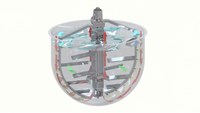
How Precision Mixing Enhances Batch Consistency in Pharmaceutical Manufacturing
Learn how precision mixing technology can improve batch consistency in pharmaceutical manufacturing by ensuring even ingredient distribution and temperature control.
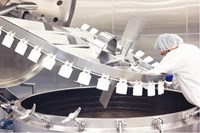
How to Prevent Downtime and Extend the Lifespan of Your Food Processing Vessels
Discover essential maintenance tips to extend equipment lifespan, reduce downtime, and lower operational costs in manufacturing.

Improvement Opportunities Checklist
Discover the secrets to achieving the elusive trifecta of speed, cost-effectiveness, and quality in food processing. While the age-old business adage suggests it's impossible to have it all, many operators are defying the odds. By honing in on key elements of production workflow design and equipment compatibility, they're revolutionizing the industry. Learn how these strategies can transform your operations and enhance your products for tomorrow...
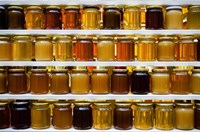
Six Tips for Food Manufacturers Purchasing Their First Mixing Vessel
For food manufacturers making the leap from small or shared-space production to expanded commercial production, processing equipment considerations can be overwhelming.
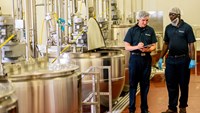
What Your Production Team Wants You to Know About Processing Vessels
Your processing vessels are used every day and are central to your operation, which means the production staff who operate your vessels learn very quickly of any shortcomings in the vessel’s design, capacity or features

Ramping Up Cosmetic Production
With growth spurred by demand for “clean beauty” and “organic makeup” products and a rising focus on inclusivity, today’s cosmetics and personal care industries are being transformed by a wave of independent and start-up manufacturers. For many of these manufacturers, the migration from small-batch lab production to larger-scale processing can be a challenge.

Looking Beyond Your Vessel Price Quote: What CFOs and Purchasing Managers Need to Know
It’s critically important for everyone involved in a new processing vessel purchasing decision to dig much deeper than simply the price quote. This blog covers some of the key factors that impact a vessel’s Total Cost of Ownership (TCO) over its service lifetime.

When Looking for a Vessel, Don’t Overlook the Value of a Professional Applications Engineer
In a world where you can buy anything you want from vendors you never meet in person, it’s easy to overlook the critical difference the right people—those real experts with real experience—can make on your success. This ideal is especially important for food, cosmetic, pharmaceutical, and other manufacturers looking for new processing vessels.

Challenge Accepted: The Impossible Barbacoa Dream
Most of the equipment we build at Lee Industries fits into one of two categories. In the first category are projects where a customer comes to us with a pretty clear picture of the equipment they need. For example, they want a 200-gallon steam-jacketed vessel to cook soup using an agitation system gentle enough to protect the integrity of solid ingredients. Well, no problem! In the second category are...
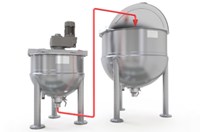
How Staggered Production Can Reduce Processing Bottlenecks
In our work with processors in key industries like food, pharmaceutical, personal care and chemicals, we often encounter production bottlenecks that can be solved with a mix of experience and creativity. One of those bottlenecks occurs when current downstream capacity can’t keep up with the desired production rate. In those situations, we’ve been able to gain significant production efficiencies by making a few equipment additions and modifying production to a staggered process: Here are a couple of techniques that have worked:
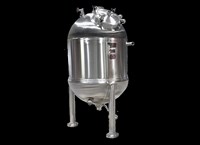
Vacuum De-Aeration: Removing Trapped Air Bubbles for Uniform Product Consistency and Accurate Dosing
Manufacturers who process high-viscosity products such as creams, lotions, ointments or gels often encounter problems with air bubbles forming in the batch, as air becomes entrained in the product during agitation. These unwanted air bubbles can prevent exact measurement and dispensing of the product in its end-use packaging, a particular problem in bio-pharma products, where highly precise dosage amounts are often required for safe and effective patient treatment.

Don’t Buy the Wrong Relationship on Your Way to Buying the Right Equipment
Gather a group of experienced processing plant managers and ask them to describe their focus when deciding which supplier to buy core equipment from and you’ll hear a range of different opinions—from construction quality and durability to equipment features and performance…and price. But one recommendation they’ll likely all share is this: evaluate the equipment manufacturer’s ability to help optimize your efficiency.
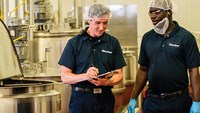
Do These Three Things Before Putting a Used Processing Vessel into Active Production
The market for used processing vessels is typically strong, due in large part to the long use life of high-quality equipment. We often see processors still using a vessel we built over 50 years ago, for example. That, and today’s high demand for new equipment, is leading even more processors to buy used equipment.
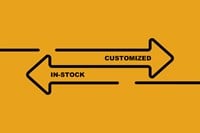
The Value of Custom-Built Processing Equipment…and What to Do If You Can’t Wait
Manufacturers that need processing equipment may have faced a similar challenge lately. While most would prefer equipment customized to their operation and product, some may feel they need to seek other options, like in-stock or used equipment. The long-term nature of processing equipment makes this a particularly important decision point: a high-quality production vessel can operate for decades.

When Food Manufacturers Must Choose Between In-House or Contract Manufacturing
Most food producers—at some point in their product’s lifecycle—arrive at a fork-in-the-road moment where they must decide to make their product in-house or outsource production to a contract manufacturer. Whether that moment occurs at the onset of a commercialization opportunity, once demand exceeds in-house capacity or when the economics reach a trigger point, determining the right production strategy can be complicated.
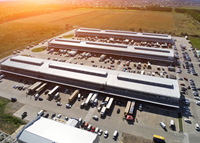
Identifying Production Bottlenecks in Process Manufacturing Operations
If you’re involved in a process manufacturing operation, you likely spend a lot of time thinking about production bottlenecks. Perhaps, if your operation is one of the many currently struggling to keep pace with increasing demand, the issue has become a top priority for you to solve.

Pet Food Safety Incident Has Manufacturers Reviewing Their Operations
Pet food safety has been a hot topic in the industry since the 2011 enactment of the Food Safety Modernization Act (FSMA), which established stringent requirements for both human and pet food manufacturers.
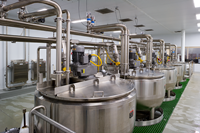
Five Equipment Decisions that Affect Efficiency and Productivity
Expansion is on the minds of many process manufacturers lately. Driven by higher demand, product innovations and new distribution channels, processors are aggressively seeking to increase production in key industries like food, pharmaceutical, personal care and chemicals.

Challenge Accepted: Accommodating Low- and High-Viscosity Product in the Same Vessel
It’s one thing to engineer a processing vessel solution to optimize production for thick, high-viscosity product. But engineering a solution that works well for a product that starts as a water-like mixture and gradually takes on the consistency of heavy paste? That is an entirely different challenge.
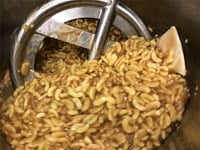
Why Mixing is So Vital to Organic Food Processing Operations
Organic food processors go to great lengths to ensure authenticity in their products. But if their end-product lacks the slices, chunks and homestyle texture expected of fresh and natural ingredients, then the extra effort and cost to comply with organic certification could go for naught. The reality is, if it doesn’t look organic, consumers may not buy it.

The Earlier the Better: When Food Manufacturers Should Bring Processing Equipment Engineers into New Product Development
Chances are, if you are in the food manufacturing industry, you think a lot about new product development. Many food manufacturers consider it to be the driving force of their organic growth. They make great investments to develop new products that attract consumer interest and widen their revenue streams. Yet, despite the emphasis, it is not uncommon for manufacturers to limit their potential by setting up shortsighted or sub-optimized production processes to produce their new products.

Where the Vessel is Always Greener: the Environmental Impact of Lee Products
Like many companies, Lee Industries has been examining its environmental footprint. We wanted to think harder about how the products we manufacture fit in a “greener” world. Because we believe it is important that our equipment operates in an ecologically friendly manner, we continually seek ways to engineer our kettles and tanks to minimize their impact on our environment. Here are some of the methods we use to support that goal:
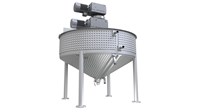
The Tell-Tale Signs of Dimple Jacket Vessel Quality
Jacketed pressure vessels – in which a jacket that surrounds a production tank is used to circulate fluid to heat or cool the vessel’s contents – are deployed throughout the food, biopharma, cosmetic, chemical and lubrication industries. For manufacturers purchasing a jacketed vessel, one of the key decisions they must make concerns the jacket’s heat transfer style.

9 Vessel Design Factors that Dramatically Affect CIP Performance
Lee Industries was one of the first vessel manufacturers to introduce CIP capabilities. Since then, we’ve learned a lot about optimizing vessel design to maximize sanitary performance and operating efficiency. Here are several best practices to help you design the best CIP-ready vessel for your operation.
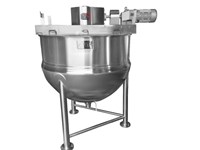
In-Stock Processing Equipment for When Custom-Built Is not an Option
Occasionally, manufacturers have an urgent need for a new vessel and don’t have the lead time required for a custom-built solution. For these situations, Lee Industries is continually manufacturing a range of our most popular models and sizes to make available as in-stock inventory upon completion. Learn more about our in-stock equipment program:
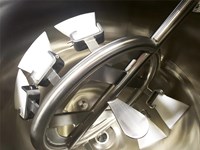
Factors That Determine the Best Agitator Design for Your Processing Operation
Processing operations involve a series of carefully engineered steps to produce, at scale, a finished product to its precise specifications. Clearly, operators that maximize the efficiency of their process and the consistency of their product gain a distinct financial advantage and more capacity to grow their business. A key contributor to accomplishing this is the operation’s processing equipment and the degree to which it is designed for the specific product and workflow.
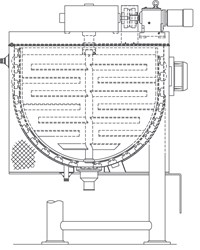
Factors That Determine the Best Processing Vessel Design for Your Operation
Knowledgeable wine drinkers know that wine glasses are designed for specific types of wines, with characteristics like shape, size, even wall thickness purposefully engineered to bring out the best in a given varietal. The difference in taste from the right vs. wrong glass style can be remarkable. The same goes for processing vessels used in food, cosmetic or pharmaceutical operations, where effectively matching product traits and operational needs to equipment design can significantly impact performance. Learn more about vessel design options in our latest blog article.
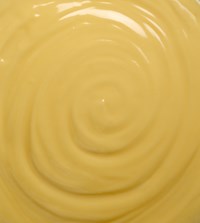
Challenge Accepted: Preventing Burn-On When Cooking Cheese Sauce in a Jacketed Kettle
As anyone who has melted cheese on a stovetop knows, it is nearly impossible to keep it from sticking to the pot. And cleaning the inside surface afterward can be difficult. This was the challenge faced recently by one of our contract process and packaging customers. See how we solved this challenge in our latest blog article:
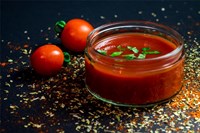
Sauce Manufacturing: Be Sure to Consider These When Choosing Your Processing Equipment
The sauce category within the food manufacturing industry is growing about 4.1% per year, spurring product innovation from both small and large processors. Processing vessel options can be as varied as the sauces themselves, with many design choices that will impact your product’s quality, consistency and production efficiency. To help you decide what’s best for your sauce processing operation, be sure to consider these factors:
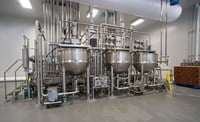
Which lasting effects of the COVID-19 crisis will food manufacturers factor into 2021 planning?
The food industry is near the top of any list of those most directly affected by the coronavirus pandemic. The entire food supply chain -- from farming and processing to distribution and consumption -- has been disrupted, in many cases dramatically. Food manufacturers are sorting through this confusion to ensure they are well-positioned to operate effectively and take advantage of new opportunities. As they look ahead to 2021, several expected long-term effects will factor into their planning. See what to expect in our latest blog article:
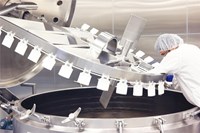
Pandemic Raises Value of Cleaning and Sanitizing Features for Processing Equipment
For food, beverage, biopharma, personal care and cosmetic product manufacturers, the need to clean and sanitize processing equipment has always been of vital importance. But in the wake of the coronavirus crisis, cleaning procedures will surely be scrutinized more heavily. Consider these equipment features to help your cleaning and sanitization efforts:

Processing Equipment Options for Food Manufacturers to Meet Crisis Demand
Demand for many packaged food products is skyrocketing. Manufacturers are doing everything they can to keep up as they ramp production, while also enforcing heightened disinfection and social distancing directives. For some manufacturers, ramping production will necessitate stocking replacement valves and parts for processing equipment to ensure continuous operation, or even adding processing kettles or tanks to increase throughput. Here is an overview of options in-demand food manufacturers can consider:

Challenge Accepted: Increasing Evaporation Rates to Accelerate Production
Some of our best work happens in the engineering room. A manufacturer of jams and jellies approached us with a unique challenge, requiring precise calculations to optimize their evaporation rates. See how we helped this client expand their heat transfer area and accelerate production.

Challenge Accepted: Faster Cooling in Jamaica
Sometimes, where you make a product will dictate how you make it. That was the case for a customer in Jamaica, a processor whose frozen food product contained ground meat. See how we helped this client meet the process time requirements in a very hot climate area.
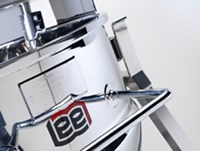
Don’t Assume Quality: The Critical Role of a Comprehensive Quality Assurance Program
We’re really picky about the quality of the kettles and tanks we build. Of course, if you rely on processing vessels in your operation, then you also need to be picky about quality, which is why we think it is helpful to understand the process we’ve developed over the years to assure the quality of every vessel before it gets delivered to the customer.

Challenge Accepted: A Tight Fit
Maneuvering around the physical constraints of a plant is a common challenge for processors. But for one of our pharmaceutical manufacturing customers, a particularly difficult space problem required a particularly innovative solution. Challenge accepted.
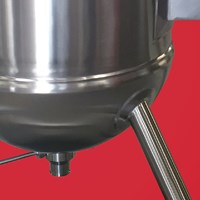
Food Industry Growth Forcing Manufacturers to Rethink Processing Equipment
We’ve been a part of the food manufacturing world for over nine decades, so we know that change is a constant for the industry. But the pace of change today – and its impact on the food manufacturing process – is more significant than ever. Here are some of the key implications we see that will affect how food manufacturers make decisions on their processing equipment:
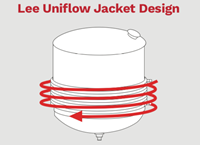
Why Do We Design Tanks with Coil Jackets?
Have you ever wondered why Lee's tanks are designed with coil jackets? See how one of the most important innovations of Lee's 90-year history makes a key difference in throughput and consistency in every batch.
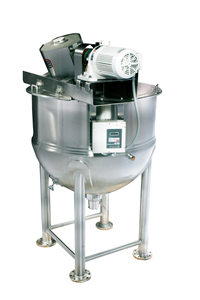
How to Make Sure the Kettle You Order is Actually the Kettle You Need
Much goes into building a high-performance processing vessel for a food, chemical or pharmaceutical manufacturing operation. Dozens of choices must be made about size, materials, mixing speeds, type of agitation, temperature, port locations, surface finishes and more. And each choice has an impact on how effectively the vessel performs in your environment. This blog article will guide your vessel design decision making and make sure you ask your process engineer the right questions.
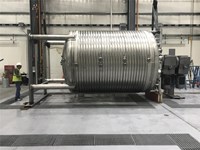
5 Vessel Design Requirements for Optimizing Food Grade, Specialty and High-Performance Lubricant Manufacturing
Food-grade, specialty and high-performance lubricants, can pose mixing, temperature and safety challenges that require specialized vessel features and performance. To meet these processing challenges, manufacturers may be wise to emphasize five key characteristics in their processing vessels for optimal results. See the five key characteristics in our latest blog article.

Limitations of Conventional Mixing Systems in Pharmaceutical Topical and Transdermal Drug Product Applications
The inherent nature of high-viscosity pharmaceutical drug products poses real operational challenges to manufacturers. To succeed, processors must seamlessly combine safe and precise ingredient loading, powerful and durable blending, and sterile and efficient cleaning within their operation. Some manufacturers have found it difficult to solve these challenges due to limitations of conventional mixing systems. Here are some of the most common issues with conventional mixing systems in pharmaceutical and other high-viscosity product settings.

Improving FSMA Compliance with Safety Features
Food safety is the top concern for food manufacturers this year, in no small part because of the FSMA. In Food Processing magazine’s annual industry survey, 27% of respondents identified food safety improvements as their top priority for this year. What components will these manufacturers scrutinize? Here are three areas where changes to manufacturing equipment can improve FSMA compliance.

Three Vessel Design Enhancements to Improve Your Throughput
Faster batch processing is a common goal for food processors. It’s often the impetus for adding more processing equipment. But improving throughput can involve much more than simply adding capacity. Depending on your objectives, optimizing your vessel design can dramatically reduce your batch processing time while also improving safety, product quality and product consistency. Here are three areas where optimizing your processing vessel can produce significant results.
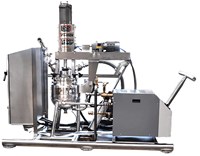
Steam or Hot Water? Which Heating Source is Best for Your Operation?
Choosing a heat source is a key consideration for all food processing operations. For processors who use a jacketed kettle design, the choice comes down to steam versus hot water. But is one of them superior? And when would you choose to use one heat source over the other? Let’s consider some of the advantages of both steam and hot water while taking a look at some potential applications.

Why Surface Finish Grades are a Key Part of Your Production Vessel
The surface finish grade is a crucial but perhaps overlooked component of your production vessel. The surface finish affects more than the look of your vessel; it’s also critically important to how your vessel accomplishes its intended task — or whether it’s able to at all. A vessel’s surface finish will determine what products can be produced within that vessel. From pharmaceuticals to chemicals to food products, each industry has surface finish standards that must be met. And even beyond industry requirements, a vessel’s surface grade can have a big effect on how your product is produced.
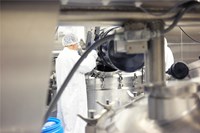
How to Meet the Challenges of High-Viscosity Mixing
Producing ointments, gels and other high-viscosity products is a challenging process. These stringently regulated products offer a high degree of difficulty for every manufacturer. Selecting the most efficient and cost-effective mixing solution can help you meet those challenges head on, but choosing the right mixing solution may be more difficult than it first appears.
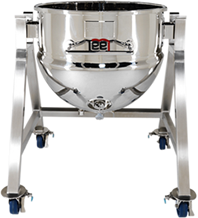
Two Ways Food Processing Kettles Prevent Waste — And Help the World
In food manufacturing, 32.4 percent of all food waste is tied to production issues, much of which could be prevented. However, food production kettles can be a big asset in the fight against food waste, both in their actual function and in the larger application of food safety guidelines in the production process. We've identified two key areas where kettles can make a difference.

Stock Vessel Replacement Parts On-Site to Make Your Maintenance More Efficient
Keeping key parts for your Lee vessel on hand in your facility means you’ll always be prepared for both scheduled and unscheduled maintenance. Think of it as a low-cost insurance policy for your equipment. What parts should you keep on-site?

Remember Your Processing Kettles During Your Upcoming Plant Shutdown
Winter shutdowns are right around the corner. For manufacturers that depend on processing kettles and tanks, preparing for these crucial weeks becomes critically important, and not just because it’s an ideal time to take care of annual maintenance. Your winter shutdown can put your facility in a position to succeed next year—or leave you chasing maintenance issues that could have been addressed much earlier.

The Importance of a Clear Manufacturing Quote for Your New Processing Vessel
Obtaining a proposal for equipment you intend to use in your processing operation is a critical part of your purchase process. Here are three key benefits of a clear, easy-to-understand manufacturing equipment quote.

Three Questions You Should Ask Your Processing Equipment Manufacturer
Preparing to buy a new piece of processing equipment can be a daunting process, but it doesn’t have to be. Knowing the right questions to ask before you buy can put you on the path to success.

Crucial Factors to Consider When Expanding Your Food Processing Operation
No matter the size of your current food processing operation, you may someday need to expand. If and when that day comes, you’ll have to address important questions regarding the expansion’s impact on your production.
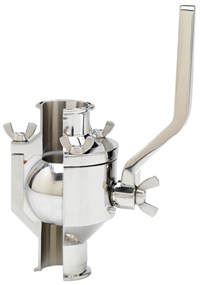
Engineering Advancements That Make Cleaning and Maintaining Your Processing Equipment More Efficient
Cleaning and maintaining processing equipment is vital for production teams in the food, beverage, bio/pharma and chemical industries, but these processes can be costly and often take up enormous amounts of time. Learn how to optimize the efficiency of your operation in this latest blog article.
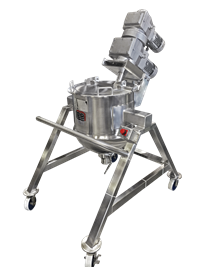
Three Ways Inclined Agitation Improves Operational Efficiency
Choosing the right kettle design is a key part of your food processing operation. When it comes to optimizing your production, there are two clear alternatives in the mixing and agitation area: horizontal ribbon blenders and hemispherical kettles with inclined agitation.

Lee Industries Receives ISO Quality Management Systems Certification
Lee Industries recently received the ISO 9001:2015 Quality Management Certification, a marker of the company’s ongoing commitment to the highest international standards of quality.
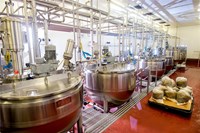
Five Questions to Ask When Buying a Used Kettle
Buying a used processing kettle can be a great option for expanding your operation or replacing older equipment. Used kettles and other vessels can often be available more quickly for lower prices than you’d see if you were buying new. But after weighing availability, price and basic design factors like shape, capacity and agitator type, there are other things you should weigh when deciding whether or not to buy a used kettle.

Use the 10X Rule to Guide Your Food Production Expansion
Your food product is taking off and you need to increase your production capacity to keep up. If that is your situation, you may be asking a fundamental question to determine your processing equipment needs: how much capacity can I get from each processing kettle without affecting my product’s quality or consistency?
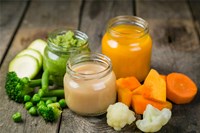
Lee Industries Explores Blending Options in Latest Production Guide
The latest production guide from Lee Industries explores the differences in the two predominant mixer styles in food production – inclined agitation kettles and horizontal ribbon blenders.
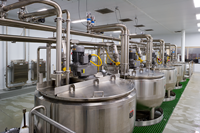
How to Improve Food Safety in Your Plant Operations
Assuring that your product will always be sanitary and free of contaminants is a critical food processing goal. So, when you are planning the design and configuration of your next kettle purchase, it is important to keep food safety in mind.
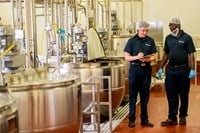
How to Improve Operator Safety in Your Food Processing Operations
During food processing, the safety of your production team is key. This article features key safety issues to consider in your food processing operation.